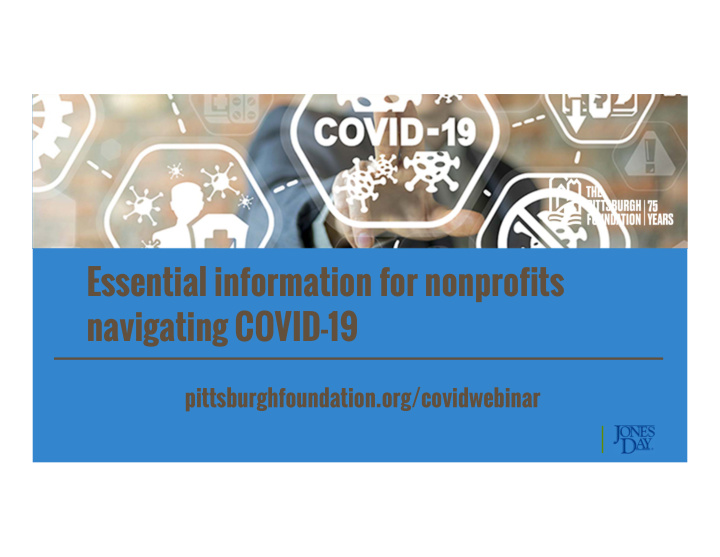



Essential information for nonprofits navigating COVID-19 pittsburghfoundation.org/covidwebinar
CORONAVIRUS JAMES S. URBAN PANDEMIC Pittsburgh Workforce Management and Caring for Employees
FINDING THE RIGHT PATH • The Priorities • Viable Plan Forward • Run the Operation • Help Employees • Minimize Cash Outlay by the Business • Minimize Administrative Burden • Be Ready to Ramp Back Up 3
TEMPORARY FURLOUGH OR TERMINATION OF EMPLOYMENT? • Employees Who are Furloughed but Remain Employed: • In this first category, employees are notified that they are being furloughed or laid off temporarily, which means the employees would remain employed (albeit inactive and without pay). • They continue to receive group benefits such as health, vision and dental (if available under the terms of the respective plans) until they are recalled to active work. • When they return, it is without the administrative burden of a rehire process. 4
TEMPORARY FURLOUGH OR TERMINATION OF EMPLOYMENT? • Employees Who are Terminated and Severed from the Payroll: • In this second category, employees are severed from the payroll and cease to be employed (while being deemed to be eligible for rehire later). • They become former employees, at least for the short term. • They cease to be eligible to participate in group benefit plans, except via COBRA continuation. 5
THE FURLOUGH PATH • Unlikely WARN Act obligations • Unlikely severance plan obligations • Possible collective bargaining obligations • Possible employment agreement obligations • Payment of accrued but unused paid time off (it depends) • Welfare benefit plan eligibility • No COBRA notice and administration • Rehire/Onboard • Unemployment compensation eligibility 6
THE TERMINATION OF EMPLOYMENT PATH • Likely WARN Act Obligations • Likely severance plan obligations • Likely collective bargaining obligations • Likely employment agreement obligations • Likely payment for accrued but unused paid time off • Welfare benefit plan ineligibility as a former employee • COBRA notice and administration • Rehire/Onboard administration • Unemployment compensation eligibility 7
UNEMPLOYMENT COMPENSATION ELIGIBILITY • While unemployment is generally viewed as being state controlled, it is a joint state-federal program that provides cash benefits to eligible workers. Each state administers a separate unemployment insurance program, but all states follow the same guidelines established by federal law. • The federal Employment and Training Administration administers unemployment insurance benefits. These benefits are primarily provided through state and local workforce development systems. • On March 12, 2020, the U.S. Department of Labor issued formal guidance to the states regarding employees displaced due to the coronavirus who are seeking unemployment compensation benefits. 8
UNEMPLOYMENT INSURANCE PROGRAM LETTER NO. 13-20 • Federal law permits significant flexibility for states to amend their laws to provide unemployment benefits in multiple scenarios related to COVID-19. 9
UNEMPLOYMENT INSURANCE PROGRAM LETTER NO. 13-20 10
UNEMPLOYMENT INSURANCE PROGRAM LETTER NO. 13-20 11
UNEMPLOYMENT INSURANCE PROGRAM LETTER NO. 13-20 12
WHAT PENNSYLVANIA SAYS 13
WHAT PENNSYLVANIA SAYS 14
WHAT PENNSYLVANIA SAYS 15
UNEMPLOYMENT CALCULATION • In Pennsylvania, the weekly benefit amount will be about 50% of your average weekly wages, subject to a weekly maximum of $573. • For someone who makes $40,000 (or $10,000 quarterly), their weekly UC benefit during normal times would be $393. • With the CARES Act premium, their weekly benefit would be increased by $600 through July 31 • $393 + $600 = $993 • $993 annualized = $51,636 16
PARTIAL UNEMPLOYMENT CALCULATION • Same example of someone who makes $40,000 ($10,000 quarterly or $19.23 per hour), and their weekly UC benefit during normal times would be $393. • They can work less than full time and still earn a normal weekly benefit. • Partially unemployed individuals enjoy a partial benefit credit equal to 30% of their normal weekly benefit ($117.90). • $393 + 117 = $510, so that person could work a reduced schedule of 26 hours and still be eligible for a normal weekly benefit of $10 • $500 + $10 + $600 = $1,110 ($57,720 annualized) 17
CARES ACT 18
Get agenda updates here: pittsburghfoundation.org/covidwebinar
Recommend
More recommend